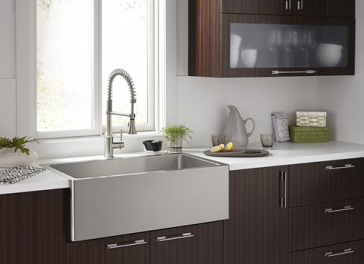The kitchen may be the heart of the home, but it’s also the resident energy hog. Plus, your kitchen contributes its share of indoor air pollution through cooking fumes and gases from flooring, paints and countertops.
The good news: Earth-friendly products are available in a wider range of styles and costs than ever before, letting you go any shade of green you desire. Here are some tips to take your kitchen to the green side.
Look for the Energy Star Label
Outdated appliances should be the first thing to go. New ones should be fairly easy to choose — just look for the Energy Star logo. These models are anywhere from 10 to 50 percent more efficient than standard models, so you’ll still need to do some research to find out which ones are the most efficient.
Get Eco-conscious Cabinets
The wood in most cabinetry contains urea-formaldehyde, which can be harmful to your health. Look for cabinets made from solid wood or alternative materials such as wheatboard, and finished with nontoxic finishes from companies like Neil Kelly Cabinets and Humabuilt.
Purchasing cabinets made with sustainable woods is another way to make your kitchen eco-friendly. Bamboo, for instance, is one of the world’s fastest-growing plants, taking just three to six years to grow large enough to harvest. Bamboo doesn’t require pesticides, which means less chemical pollution and cleaner air. Eucalyptus is another good option.
Get Creative With Countertops
Countertops made from recycled paper or hemp are extremely durable and easy to clean, but the color selection can be limited. Squak Mountain Stone looks and feels like natural soapstone, but it is actually made of more than 60 percent post-consumer and post-industrial waste, including recycled paper, recycled glass, coal fly ash and Portland cement. The result is an environmentally friendly product that weighs 50 percent less than traditional concrete slabs of similar size, but is just as durable.
Natural stone countertops can also be considered green because of long life.
Work With What You Already Have
Think “refresh,” not “remodel.” New paint and updated hardware for cabinets can give a new look without producing the landfill waste that remodeling generates. The less you spend to get the job done, the more likely you are to get a return on your investment when you sell.
Most major paint manufacturers now make zero- or low-VOC paints, which means they emit fewer volatile organic compounds. VOCs are linked to health problems and are considered greenhouse gases; the fewer in your home, the better.
Don’t Forget to Ventilate
One of the first things to consider is indoor air quality. Since we spend the majority of our time in the house, making sure the air is clean is priority No. 1.
One simple way to improve air quality is to install a range hood.
Add a Built-in Recycling Center
When you’re mapping out your cabinet space, leave a spot for recycling bins near your trash can. The easier it is to recycle, the more likely that you and future residents will make the effort.
Save Water Where You Can
Though the bathroom is the biggest water hog in a house, the kitchen uses its fair share of water for dishes, cooking and cleaning.
Choose faucets with aerators, which inject air bubbles into the water to get the same pressure with less volume. Adding a re-circulation pump will keep hot water at the tap, so you won’t need to run the water while the temperature rises.
Get Eco-friendly Flooring
Many hardwood floors are made from old-growth trees, stripping forests of these towering creatures. Luckily, there are attractive alternatives that keep the forest intact. Flooring materials like bamboo or cork, for instance, can be quickly replenished.
Linoleum is enjoying a comeback, largely due to its green properties. Made of natural materials such as linseed oil, rosin and wood flour, it is durable and easy to clean.
Light Up the Room With LED or Fluorescent Bulbs
Green living doesn’t stop at the ceiling. Avoid recessed cans, unless they use fluorescent bulbs and are airtight, to keep air from escaping around the can and into the attic. Add long-lasting fluorescent bulbs to your fixtures, or invest in pricier LED lighting.
Motion and occupancy sensors save money by automatically turning lights on and off as needed. They are fairly inexpensive and can be mounted in standard switch boxes. Scott Martin, a green kitchen designer from San Francisco, also recommends dimmers, which will save energy and prevent flickering.
Add the Finishing Touches Without the Toxins
Thanks to companies like Ecos, AFM Safecoat and Yolo, eco-friendly paints, stains and finishes reduce exposure to these harmful volatile organic compounds. Seek out water-based finishes with “No VOCs” on the label.
Eco-friendly wallpaper products are also available, with low- or no-VOC compositions and glues. Look for papers from Mod Green Pod, Phillip Jeffries and Woodson & Rummerfield. Don’t forget the low-VOC caulks, adhesives and sealers.
Want to learn more ways to turn your house into a green home? Head over to International Bath & Tile, where our expert employees will be able to help you accomplish your eco-friendly home.
